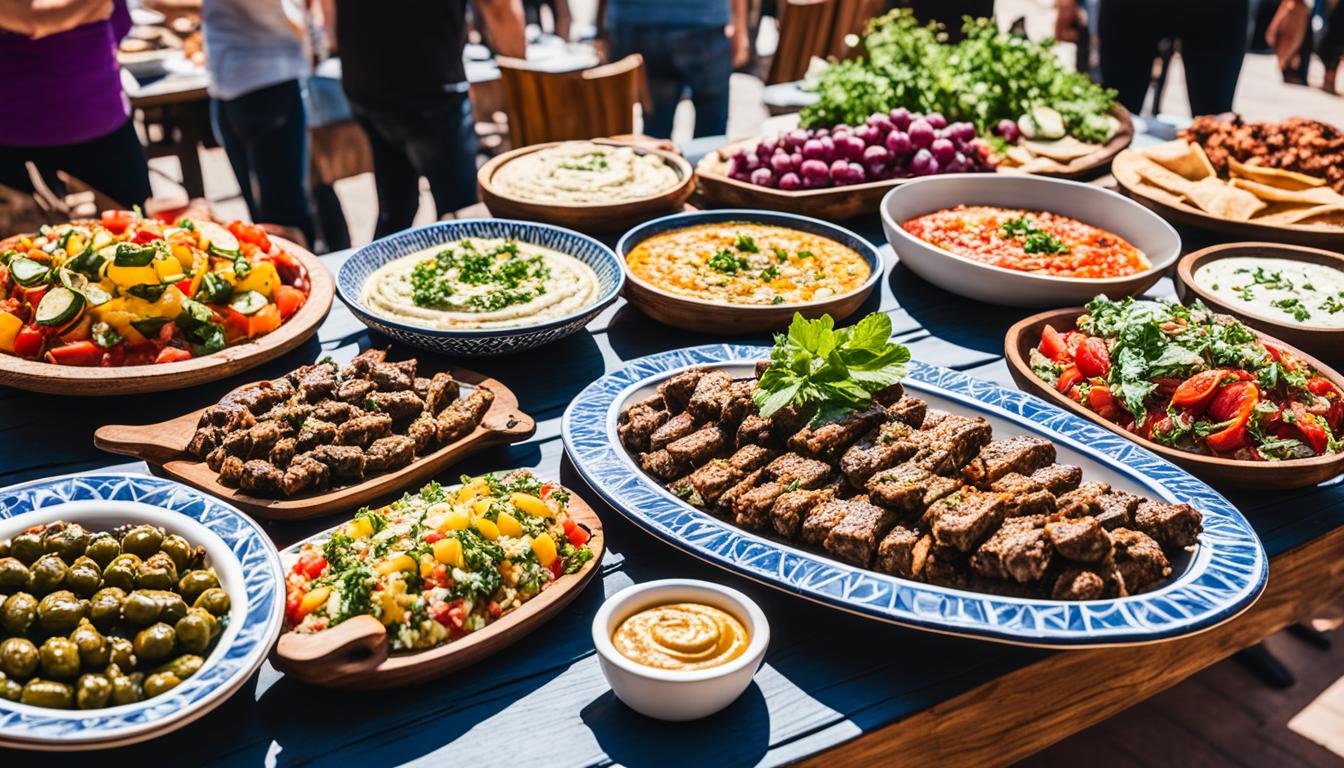A Food Lover’s Guide to the Best Cuisine in Turkey!
What if you could embark on a culinary journey that takes you through the rich tapestry of Turkish culture and tradition? From the vibrant spices that enliven every dish to the artfully crafted desserts that delight the senses, Turkish cuisine is a captivating feast for the palate. In this comprehensive guide, we’ll uncover the essence of this beloved culinary tradition and reveal the hidden gems that make it a must-visit destination for every food lover.
Key Takeaways
- Turkish cuisine is renowned for its fresh, flavorful ingredients like olive oil, herbs, and spices1
- Traditional Turkish meals feature a variety of dishes, from hearty breakfasts to delectable desserts1
- Unique cooking techniques, such as grilling over a mangal and slow cooking in clay pots, contribute to the distinctive flavors1
- Turkish beverages, including tea, coffee, and traditional drinks like ayran and salep, are an integral part of the cuisine1
- Istanbul, the cultural heart of Turkey, offers a rich tapestry of culinary experiences, from traditional eateries to innovative new restaurants2
The Essence of Turkish Cuisine
Turkish cuisine is a culinary treasure trove, brimming with flavors that captivate the senses. At the heart of this vibrant gastronomic landscape lies the iconic kahvaltı, the traditional Turkish breakfast3. This meal is a feast for the eyes and the palate, featuring a delightful array of cheeses, olives, breads, eggs, tomatoes, cucumbers, jams, and honey4. No Turkish breakfast is complete without the aromatic and invigorating Turkish tea, served in the signature tulip-shaped glasses.
As the day progresses, Turkish cuisine unveils its diverse tapestry of flavors. Dinner often starts with a light, comforting soup, followed by a main course featuring succulent meat dishes, fish dishes, or the beloved dolmas (stuffed vegetables)5. The meal is often accompanied by a side of fragrant pilaf or vibrant vegetable dishes. The culinary journey concludes with a sweet and indulgent dessert, leaving a lingering impression on the palate.
The essence of Turkish cuisine lies in its deep-rooted traditions and the mastery of time-honored cooking techniques. From the sizzling grills over a mangal to the slow-cooked delicacies in stone ovens and clay pots, each method imparts a unique character to the dishes. The art of sautéing in butter or olive oil, along with the intricate process of fermentation, further enhances the flavors and textures that define the sahan (Turkish cuisine)4.
The diversity and rich heritage of Turkish cuisine are a testament to the country’s vibrant culinary culture4. From the bustling streets of Istanbul to the remote corners of Anatolia, the essence of Turkish cuisine is woven into the fabric of the nation, captivating the hearts and palates of those who venture into its flavorful realm5.
Turkish Cuisine Guide: Regional Delights

From the savory delight of baklava to the simple satisfaction of a well-made kebab, Turkish traditional dishes are a testament to the country’s culinary creativity6. Turkish cuisine offers a diverse range of breakfast items including bread, tomatoes, butter, honey, jam, olives, cheese, eggs, yogurt, cucumbers, peppers, fresh fruit, bologna, simit, pastries, and cake6. Meze, small dishes served to accompany alcoholic drinks or as appetizers before the main dish, are essential to Turkish dining6. Salads are fresh and often include ingredients like beans, cucumbers, onions, and tomatoes.
Turkish desserts are famously rich and diverse, including baklava, künefe, and Turkish delight6. Turkish cuisine is a blend of flavors and spices from Asia, the Middle East, and Eastern Europe, shaped and refined since the days of the Ottoman Empire7. Fruits are celebrated in Turkey, with new seasonal fruits appearing abundantly at fruit stalls when in season7. Watermelon is a popular choice during hot weather, often served with crumbly cheese for a refreshing combination7.
The country is also renowned for its unique beverages, such as Turkish tea, Turkish coffee, ayran, and salep6. Turkish coffee is prepared by finely grinding beans, boiling them with sugar, and serving it in a concentrated cup, with grounds not ingested6. Turkish tea (çay) is a popular beverage, with black tea being the preferable choice over apple tea6.
From the bustling *local markets* to the vibrant *Turkish street food*, the diverse culinary landscape of Turkey offers a delightful array of regional delights to savor7. *Turkish desserts* and *Turkish beverages* further enhance the rich and distinctive flavors that make Turkish cuisine a true gastronomic treasure678.
Conclusion
Turkish cuisine is a vibrant, diverse, and deeply rooted culinary tradition that offers a wide range of flavors, techniques, and regional specialties9. From the hearty breakfasts to the indulgent desserts, the essence of Turkish cuisine lies in its use of fresh, flavorful ingredients, traditional cooking methods, and the cultural significance of shared meals910., This comprehensive guide has explored the key aspects of Turkish cuisine, providing insights into the country’s rich culinary heritage and the unique experiences awaiting food lovers who venture to explore the depths of this extraordinary gastronomic landscape911.,
Turkish cuisine has evolved over centuries, shaped by the rich history and diverse cultures that have traversed the lands of modern-day Turkey11. The Ottoman Empire had a profound impact on Turkish cuisine, lasting for over six centuries and spanning three continents11. Additionally, the influence of Middle Eastern, Balkan, and Mediterranean cuisines, particularly during the Ottoman era, has contributed to the vibrant and diverse flavors that characterize Turkish cuisine today91110.,,
As we delve deeper into the world of Turkish cuisine, we discover a tapestry of regional specialties, each reflecting the unique natural resources and geographical influences of its locale911., From the seafood-centric dishes of the Aegean region to the corn and cabbage-based meals of the Black Sea area, Turkish cuisine showcases the richness and diversity that make it a culinary treasure trove911., By exploring this extraordinary gastronomic landscape, food lovers can immerse themselves in the cultural traditions, hospitality, and shared experiences that are the hallmarks of Turkish cuisine910.,







